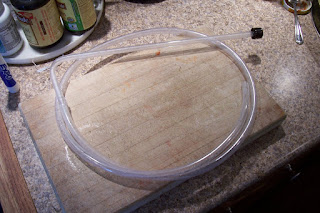First a few basic terms and definitions.

a primary - a food grade plastic bucket (left)where the fruit, water and preservatives (right) are mixed and the initial fermentation is started. A primary can be any size, I currently have a 2 gallon bucket which will yield about 1 to 1/2 gals of wine per batch, there are 6 gal primary's and for the commercial winemaker 100 + gals tanks.

A secondary - a glass or plastic bottle 1 gal or more also known as a carboy I use glass because it does not seep flavors into the wine, the liquid from the primary is siphoned off the pulp and into the secondary (carboy), fermentation is continued for 2 months to a year before bottled.
must - the mixture of pulp and liquid in the primary
 Specific gravity or SG - SG is the measure of how much sugar is mixed into the primary, water has an SG of 1.000, in wine making, we want to mix enough sugar into the mix to have a starting SG of 1.095, this is a magic number that ferments to an alcohol % of about 12.
Specific gravity or SG - SG is the measure of how much sugar is mixed into the primary, water has an SG of 1.000, in wine making, we want to mix enough sugar into the mix to have a starting SG of 1.095, this is a magic number that ferments to an alcohol % of about 12.Different fruits have different sugar contents, So the amount of sugar added is different for every recipe and different for the same fruit from year to year due to humidity, sun, rain and other environmental conditions. That is why recipes that you find online or in books can not be followed exactly, you have to measure and adjust the sugar as you go to work with what fruit you have. but with this process you can ferment nearly anything into wine, I have even heard about a chocolate strawberry wine that turned out pretty good. above is a picture of a test tube which is filled with wine and tested using a hydrometer.
 siphon tube - 3 ft plastic piece of clear food grade hose that is used to move the wine from the primary to the secondary or from one carboy to another, think of someone stealing gas except that you swallow some wine not a deadly toxin, unless you don't stop drinking the wine through your big plastic straw but that is another topic all together.
siphon tube - 3 ft plastic piece of clear food grade hose that is used to move the wine from the primary to the secondary or from one carboy to another, think of someone stealing gas except that you swallow some wine not a deadly toxin, unless you don't stop drinking the wine through your big plastic straw but that is another topic all together.
racking (left) - is the process of siphoning liquid from one container to another, for instance siphoning wine from one carboy to another then setting it back on the "RACK" for another two months. and racking is done every 2 to 3 months until the wine becomes clear.

An Airlock( left) - A double chamber airlock is attached to a cork and filled with water, it lets the CO2 the yeast produce escape without letting air in.
 yeast (left) - the living organisms that turn the sugar into alcohol. These little miracle workers have the greatest job, Eat sugar all day until you die. What we drink is the waste from the yeast, I bet you all wanted to know that.
yeast (left) - the living organisms that turn the sugar into alcohol. These little miracle workers have the greatest job, Eat sugar all day until you die. What we drink is the waste from the yeast, I bet you all wanted to know that. Hydrometer (left) - An instrument for measuring the specific gravity relative to sugar content of a liquid, these are used in salt water fish tanks as well to measure the salt content in the tank. it looks a little like long skinny glass bobber.
Hydrometer (left) - An instrument for measuring the specific gravity relative to sugar content of a liquid, these are used in salt water fish tanks as well to measure the salt content in the tank. it looks a little like long skinny glass bobber.stay tuned any you will undoubtedly learn something. And who doesn't want to learn about making alcohol?
thanks for reading

No comments:
Post a Comment